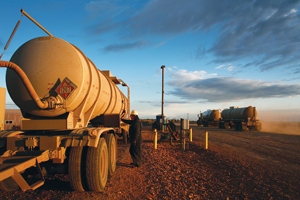Crumbling Roads in Oil Fields Slow US Energy Boom

In southern Texas and North Dakota, where shale drilling has propelled U.S. oil production to the highest level in 28 years, thousands of 18-wheel trucks are rumbling to wells on roads designed decades ago for farmers to bring crops to markets. Road closures have slowed output, with diverted traffic increasing accidents, as Texas seeks $1 billion to maintain roads in the oil belt.
With the U.S. projected to be energy self-sufficient by 2030, according to BP Plc, crumbling highways may threaten billions of dollars of investment in the oil patch. Because more wells are being drilled using hydraulic fracturing, there’s greater need for truckloads of water, sand and chemicals, as well as steel structures used in the process in fields often miles from major roads.
“If you drive a cattle truck one or two times a year, you’re not affecting that road very much, but the first day you drive a 175,000-pound substructure of a drilling rig up that road you begin to destroy it,” Daryl Fowler, the county judge in DeWitt, Texas, said by phone May 20. “You’re looking at $2 billion of capital investment in our county alone that will be thwarted or curtailed completely if the road system is abandoned and they can’t get their product to market.”
In North Dakota, nice weather may cause the biggest road problems. As the freezing winter thaws into spring, soil softens beneath roads and the state highway department restricts truck loads. The limits typically last from March through May or June, and for the past five years they’ve stayed on some highways in the Bakken area year-round.
Road issues, bad weather and exhausted wells have hampered crude production growth in North Dakota. Oil output from the state’s portion of the Bakken shale grew 24,000 barrels a day between December and April after growing 166,000 barrels a day from June through November last year.
North Dakota’s Department of Transportation has increased its road construction budget to $800 million a year from $250 million in 2007, Jamie Olson, a Bismarck-based spokeswoman said by phone July 3.
The Texas Department of Transportation is hoping that residents will pass a November constitutional amendment that would allow a $1.4 billion portion of oil and gas tax revenue that currently goes to a rainy day fund to be slotted for highway work instead.
“We know that $1 billion will be needed to maintain roadways in all energy producing areas of our state, including South Texas,” Nick Wade, spokesman for the department, said by e-mail July 9. “That’s in addition to the $1 billion needed for regular road maintenance, and the estimated $3 billion for new construction to address congestion,” he said.
The Texas legislature passed bills last year allotting $225 million to the state highway department and another $225 million to counties to repair roads damaged by oil-field trucks.
It was the first time the state has ever given county governments money for road projects, Fowler said. The money doesn’t get counties very far, though. DeWitt expects to get $4.9 million, compared to an engineering estimate of $432 million to fortify the 315 miles of roads it maintains. La Salle County has sued the state, alleging that most affected counties aren’t getting a large enough share.

